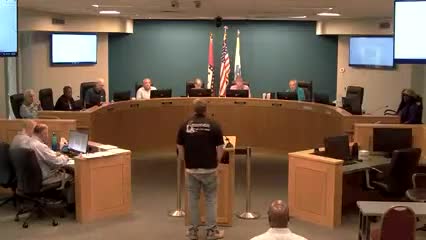Piercy property owner navigates zoning changes and lot split approvals
May 10, 2025 | Hot Springs City, Garland County, Arkansas
This article was created by AI summarizing key points discussed. AI makes mistakes, so for full details and context, please refer to the video of the full meeting. Please report any errors so we can fix them. Report an error »

In the heart of Hot Springs, Arkansas, a recent Planning Commission meeting brought to light the complexities of land zoning and property development. As the city hall buzzed with anticipation, one resident, who had recently purchased a property on Airport Road, shared his journey through the often convoluted process of land division and zoning changes.
The resident recounted his experience of acquiring the property last year, a venture that quickly turned into a detailed navigation of local regulations. He initiated a lot split in November, which took several months to finalize, culminating in February. This process was particularly significant as it coincided with a zoning change that altered the landscape of his property. The left side of his land transitioned from M-1 zoning to rural residential, while the right side shifted to light industrial, creating a unique situation where two different zoning classifications applied to the same parcel.
During the meeting, he explained how he dedicated Wayne Place to the city, a move that underscored his commitment to the community. His narrative highlighted the challenges faced by property owners as they adapt to changing regulations and zoning classifications. The resident expressed his discussions with city officials, who assured him that the new zoning would be equivalent to what he had previously.
As the meeting progressed, the atmosphere was charged with a sense of community engagement. The resident's story resonated with many, illustrating the intricate dance between personal investment and municipal planning. The Planning Commission's deliberations on such matters are crucial, as they shape the future of neighborhoods and the experiences of those who call them home.
With the complexities of zoning and land use at the forefront, the meeting served as a reminder of the ongoing dialogue between residents and city officials. As Hot Springs continues to grow and evolve, the decisions made in these meetings will undoubtedly impact the community for years to come.
The resident recounted his experience of acquiring the property last year, a venture that quickly turned into a detailed navigation of local regulations. He initiated a lot split in November, which took several months to finalize, culminating in February. This process was particularly significant as it coincided with a zoning change that altered the landscape of his property. The left side of his land transitioned from M-1 zoning to rural residential, while the right side shifted to light industrial, creating a unique situation where two different zoning classifications applied to the same parcel.
During the meeting, he explained how he dedicated Wayne Place to the city, a move that underscored his commitment to the community. His narrative highlighted the challenges faced by property owners as they adapt to changing regulations and zoning classifications. The resident expressed his discussions with city officials, who assured him that the new zoning would be equivalent to what he had previously.
As the meeting progressed, the atmosphere was charged with a sense of community engagement. The resident's story resonated with many, illustrating the intricate dance between personal investment and municipal planning. The Planning Commission's deliberations on such matters are crucial, as they shape the future of neighborhoods and the experiences of those who call them home.
With the complexities of zoning and land use at the forefront, the meeting served as a reminder of the ongoing dialogue between residents and city officials. As Hot Springs continues to grow and evolve, the decisions made in these meetings will undoubtedly impact the community for years to come.
View full meeting
This article is based on a recent meeting—watch the full video and explore the complete transcript for deeper insights into the discussion.
View full meeting
